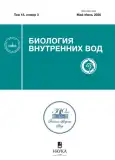Радиоэкологическое исследование озерной лягушки Pelophylax ridibundus как компонента водной экосистемы оз. Кожакуль (Южный Урал)
- Авторы: Чеботина М.Я.1, Гусева В.П.1, Берзин Д.Л.1, Смагин А.И.2,3
-
Учреждения:
- Институт экологии растений и животных, Уральское отделение Российской академии наук
- Челябинский государственный университет
- Федеральное медико-биологическое агентство Российской Федерации
- Выпуск: Том 18, № 3 (2025)
- Страницы: 516–523
- Раздел: ВОДНАЯ ТОКСИКОЛОГИЯ
- Статья опубликована: 04.09.2025
- URL: https://vestnik.nvsu.ru/0320-9652/article/view/686994
- DOI: https://doi.org/10.31857/S0320965225030128
- EDN: https://elibrary.ru/IZFYLW
- ID: 686994
Цитировать
Полный текст
Аннотация
Проведено исследование накопления антропогенных радионуклидов 90Sr и 137Cs озерной лягушкой Pelophylax ridibundus Pall., 1771 в оз. Кожакуль, примыкающем к юго-восточной границе Восточно-Уральского радиоактивного следа. Концентрации 90Sr во взрослых представителях амфибий в месте отбора проб варьируют в ~100 раз, а 137Cs – в 4 раза. Все сравниваемые концентрации 90Sr и 137Cs в компонентах оз. Кожакуль (взрослые лягушки, кладофора, окунь, илистый грунт) значительно выше аналогичных средних значений в водоемах Среднего Урала, не подвергшихся крупным радиоактивным воздействиям и аварийному загрязнению. Получено, что 60% взрослых лягушек загрязнены 90Sr выше допустимого норматива, установленного для рыб, сеголетки лягушек приближаются к этому нормативу. Сделан вывод, что изученный вид амфибий может быть хорошим биоиндикатором загрязнения этим радионуклидом водных экосистем в местах радиоактивного загрязнения.
Ключевые слова
Полный текст
Об авторах
М. Я. Чеботина
Институт экологии растений и животных, Уральское отделение Российской академии наук
Автор, ответственный за переписку.
Email: Chebotina@ipae.uran.ru
Россия, Екатеринбург
В. П. Гусева
Институт экологии растений и животных, Уральское отделение Российской академии наук
Email: Chebotina@ipae.uran.ru
Россия, Екатеринбург
Д. Л. Берзин
Институт экологии растений и животных, Уральское отделение Российской академии наук
Email: Chebotina@ipae.uran.ru
Россия, Екатеринбург
А. И. Смагин
Челябинский государственный университет; Федеральное медико-биологическое агентство Российской Федерации
Email: Chebotina@ipae.uran.ru
Южно-Уральский институт биофизики
Россия, Челябинск; ОзерскСписок литературы
- Берзин Д.Л., Чеботина М.Я., Гусева В.П. 2020. Накопление радионуклидов в озерной лягушке Pelophylax ridibundus в зоне атомного предприятия // Биология внутр. вод. № 6. С. 613. https://doi.org/10.31857/S0320965220060042
- Вершинин В.Л. 1997. Экологические особенности популяций амфибий урбанизированных территорий // Автореф. дис. … докт. биол. наук. Екатеринбург: Полиграфист. 47 с.
- Вершинин В.Л. 2007а. Специфика жизненного цикла R. arvalis Niss. на территории Восточно-Уральского радиоактивного следа // Сиб. экол. журн. С. 677.
- Вершинин В.Л. 2007б. Амфибии и рептилии Урала. Екатеринбург: Учреждение Российской академии образования “Уральское отделение”.
- Восточно-Уральский радиоактивный след (сборник статей, посвященных последствиям аварии 1957 г. на ПО Маяк. 2012. Челябинск: Фрегат.
- Гатиятуллина Э.З. 1990. Митотическая активность покровного эпителия обыкновенной полевки и остромордой лягушки в условиях антропогенного загрязнения // Животные в условиях антропогенного ландшафта. Екатеринбург: УрО РАН. С. 91.
- Гусева В.П., Чеботина М.Я., Ищенко В.Г., Берзин Д.Л. 2017. Накопление радионуклидов амфибиями (Pelophylax ridibundus Pall.), обитающими на Среднем Урале // Сиб. экол. журн. № 1. С. 99.
- Елисеева К.Г., Войтович А.М., Плоская М.В. и др. 1994. Генетический мониторинг популяций бурых лягушек, обитающих в загрязненных радионуклидами районах республики Беларусь // Радиационная биология. Радиоэкология. Т. 34. Вып. 6. С. 838.
- Захаров В.М., Кларк Д.М. 1993. Биотест: интегральная оценка здоровья экосистем и отдельных видов. М.: Биотест.
- Левина С.Г., Попова И.Я., Захаров С.Г. и др. 2004. Гидрохимические особенности распределения 90Sr и 137Cs в озерных системах осевой части Восточно-Уральского радиоактивного следа // Рос. хим. журн. Вып. XLVIII. № 2. С. 94.
- Нормы радиационной безопасности (НРБ 99/2009): санитарные нормативы. 2009. М.: Центр санитарно-эпидемиологического нормирования, гигиенической сертификации и экспертизы; Минздрав России. 110 с.
- Парфилова Н.С., Левина С.Г. 2013. Содержание 90Sr и 137Cs в компонентах водосборной территории озера Кожакуль на современном этапе // Вестн. Челябинск. гос. пед. ун-та. С. 296.
- Пястолова О.А., Вершинин В.Л., Трубецкая Е.А. и др. 1996. Использование амфибий в биоиндикационных исследованиях территории ВУРСа // Экология. № 5. С. 378.
- Родионова Н.В., Мажуга П.М., Домашевская Е.И. и др. 1994. Изменения в гистоструктуре костного скелета у амфибий, обитающих в зоне отчуждения ЧАЭС // Проблемы Чернобыльской зоны отчуждения. Вып. 1. С. 139.
- Смагин А.И. 2013. Экология водоемов в зоне техногенной радионуклидной геохимической аномалии на Южной Урале. Челябинск: Издат. центр ЮУргу.
- Смагин А.И. 2023. Гигиеническая оценка загрязнения 90Sr и 137Сs воды и рыбы в озерах головной части периферийной зоны Восточно-Уральского радиоактивного следа // Гигиена и санитария. Т. 102. С. 208. https://doi.org/10.47470/0016-9900-2023-102-3-208-213
- Смагин А.И., Дмитриева А.В., Тарасов О.В. и др. 2011. Исследование радиоэкологических особенностей оз. Кожакуль // Вопросы радиационной безопасности. № 2. С. 44.
- Трапезников А.В., Чеботина М.Я., Трапезникова В.Н. и др. 2008. Влияние АЭС на радиоэкологическое состояние водоема-охладителя. Екатеринбург: Академнаука.
- Чеботина М.Я., Гусева В.П., Берзин Д.Л. 2024. Радиологические исследования озерной лягушки (Pelophylax ridibundus) в водоемах Среднего Урала // Биология внутр. вод. № 3. С. 469. https://doi.org/10.31857/S0320965224030111
- Beresford N.A., Barnett С.L., Gashchak S. et al. 2020. Radionuclide transfer to wildlife at a ‘Reference site’ in the Chernobyl Exclusion Zone and resultant radiation exposures // J. Environ. Radioactivity. V. 211. P. 1. https://doi.org/10.1016/j.jenvrad.2018.02.007
- Burraco P., Car C., Bonzom J.-M. et al. 2021. Assessment of exposure to ionizing radiation in Chernobyl tree frogs (Hyla orientalis) // Sci. Reports. V. 11. e20509. https://doi.org/10.1038/s41598-021-00125-9
- Jagoe C.H., Majeske A.J., Oleksyk T.K. et al. 2002. Radiocesium concentrations and DNA strand breakage in two species of amphibians from the Chernobyl exclusion zone // Radioprotection. V. 37. № 1. P. 873. https://doi.org/10.1051/radiopro/2002217
- Matsushima N., Ihara S., Takase M. et al. 2015. Assessment of radiocesium contamination in frogs 18 months after the Fukushima Daiichi nuclear disaster // Scientific Reports. V. 5. P. 1. https://doi.org/10.038/srep09712
- Stark K., Avila R., Wallberg P. 2004. Estimation of radiation doses from 137Cs to frogs in a wetland ecosystem // J. Environ. Radioactivity. V. 75. P. 1. https://doi.org/10.1016/j.jenvrad.2003.12.01
Дополнительные файлы












